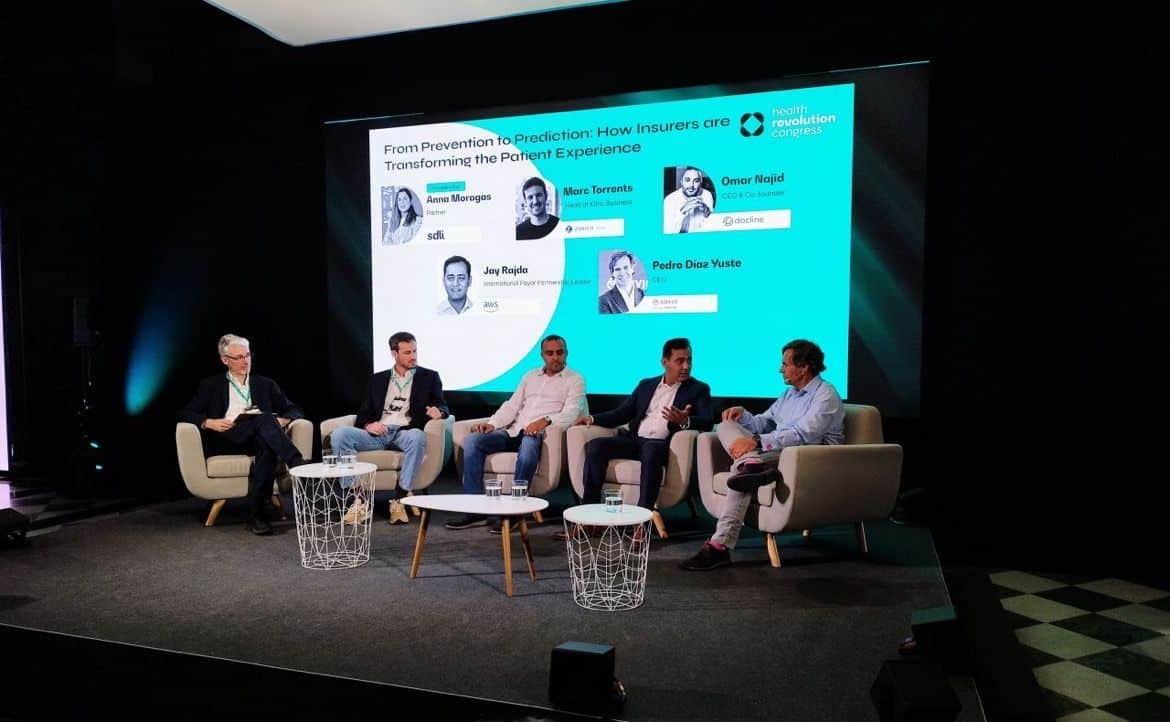The Health Revolution Congress has undoubtedly been the event of the year in digital health. Organized by the Barcelona Health Hub together with the Generalitat de Catalunya-Accio, the Barcelona City Council (Ajuntament de Barcelona) -Barcelona Activa and the Barcelona Chamber of Commerce (Cambra de Barcelona), it has collected the latest news in the sector from all possible angles.
At SDLI we work very closely with the sector, both with the National Health System and with pharmaceutical companies. In this case, and due to our experience also in the insurance sector, Xavier Lesauvage, SDLI Senior Partner, moderated the panel “From prevention to prediction: how insurers are transforming the patient experience” in which we were able to discuss the digitization of health insurance.
We had the opportunity to speak for more than 30 minutes with four experts on the subject. Jay Rajda of Amazon Web Services, International Payor Partnerships Leader, who works with global clients to enable them to achieve their business goals using technology. Marc Torrents from Zurich, Head of Klinc, who leads the development of innovative digital insurance products with a focus on wellness and personalization. Pedro Diaz, the CEO of Savia, a Mapfre subsidiary, who leads the development of a new digital health initiative, integrating different start-ups in the health-technology area. And with Omar Najid of Docline, a digital health platform of which he is the founder and which aims to make healthcare more accessible through technology.
The first topic we talked about was the convergence of health and well-being, the so-called wellcare. It is a trend in which insurance companies are fully immersed, evolving towards a proactive approach that focuses on the early identification of possible risks and the promotion of the health and well-being of patients.
Achieving this is a technological challenge for AWS, it is addressed by making its infrastructure available to insurers so they don’t have to worry about it and can focus on innovating and creating better solutions and customer value. The AWS solution makes thousands of servers available to its customers, allowing them to technologically validate their solutions much more easily.
At Savia, their service revolves around the digital platform, based on everything they have learned from Mapfre and its technology partners, which allows them to provide digital health services in SaaS format. It is a complete solution that has both a B2C and a B2B vision. For insurers it allows them to have a platform to offer it to their client. Regarding wellbeing, both Savia and Mapfre are introducing digital services that are highly targeted at it, achieving more satisfied customers and lower management costs.
We continue with one of the topics that has been giving the most talk in recent months, artificial intelligence. This, along with similar technologies, is allowing insurance companies to process large amounts of data to generate valuable information on possible risks for patients and improve the precision of personalized healthcare solutions.
Focusing on this area, at Klinc they have the objective of using technology to prevent, with which they are currently working on AI solutions, more oriented to empower medical teams.
At Docline, they started helping doctors and healthcare professionals with their telemedicine system. Subsequently, they have focused on insurers using their all-in-one platform, with the ability to be very flexible and adapt to customer needs. Omar points out that technology is not the only thing that matters, nor the investment you make in R&D, but also the flexibility and how the platform is capable of helping customers also matters.
Finally, we cover the topic of wellbeing ecosystems, as insurers can create integrated wellbeing ecosystems that offer personalized digital health solutions and other value-added services to improve customer experience and retention, while reducing medical costs and improve risk assessment.
At Savia they understand that to offer wellness as services, which generates an ecosystem around the insurer, it is necessary to have technological capacity. To do this, they have developed a platform that is offered to anyone so they can take advantage of it to create new services, focusing on their users and not having to create new technologies. They work with more than 10 startups that provide solutions through their platform and can provide these services.
Klinc detects a very clear gap, which they solve by creating an ecosystem of different services that cover wellbeing as something holistic. In his experience, beyond technology, the services that make up the ecosystem must have a human touch, be interesting for different segments and, of course, be scalable.
At Docline they believe that medical costs and waiting lists are the biggest challenges in the health system. The relationship between insurers and the health system could solve these challenges by uniting the platforms of insurers based on digital health and the health system itself.
We conclude the session with Jay explaining how to make an integrated system work. From his perspective, success is based on the integration of three key factors:
- The first is how to get all the data in one place to get the full picture
- The second deals with how to analyze them to always get the necessary information.
- The third answers the question, and what do I do with it?
As explained by the AWS manager, there are cases in which this integration has been able to be put into practice by having good data and adding a layer of analysis; With this, the system itself has been able to predict possible ailments and recommend solutions to medical professionals. A clear case of how to move from prevention to prediction.
In our round table we have been able to see different solutions, all of them aimed at providing a better service to the insured, the patient and also to the System and the insurance companies. With all this, we can expect a future in which current frictions become milder and technology is capable of overcoming the challenges we are currently experiencing in health and the sector.




